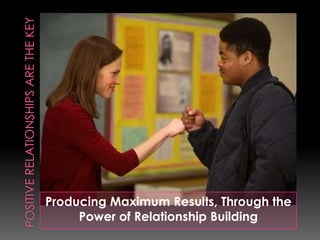Relationship building and_hope
•Télécharger en tant que PPTX, PDF•
0 j'aime•418 vues
This Power Point presentation shows the value of hope and relationship.
Signaler
Partager
Signaler
Partager

Recommandé
Recommandé
Presentation from The World of ADHD According to S.P.A.C.E. by Gareth MorewoodWorking effectively with schools; why co-production is essential for good out...

Working effectively with schools; why co-production is essential for good out...SPACE Stockport ADHD Group
Bullying Prevention: Research Highlights from UB's Alberti Center

Bullying Prevention: Research Highlights from UB's Alberti CenterUB Alberti Center for Bullying Abuse Prevention
Contenu connexe
Tendances
Presentation from The World of ADHD According to S.P.A.C.E. by Gareth MorewoodWorking effectively with schools; why co-production is essential for good out...

Working effectively with schools; why co-production is essential for good out...SPACE Stockport ADHD Group
Bullying Prevention: Research Highlights from UB's Alberti Center

Bullying Prevention: Research Highlights from UB's Alberti CenterUB Alberti Center for Bullying Abuse Prevention
Tendances (20)
Accommodations for Aggressive Youth in School Settings

Accommodations for Aggressive Youth in School Settings
Working effectively with schools; why co-production is essential for good out...

Working effectively with schools; why co-production is essential for good out...
Bullying Prevention: Research Highlights from UB's Alberti Center

Bullying Prevention: Research Highlights from UB's Alberti Center
En vedette
En vedette (20)
A influência de um bom relacionamento interpessoal num

A influência de um bom relacionamento interpessoal num
Preparing for the Future: The Power of Relationships

Preparing for the Future: The Power of Relationships
Strategies for Building Effective Relationship Presentation

Strategies for Building Effective Relationship Presentation
Similaire à Relationship building and_hope
Similaire à Relationship building and_hope (20)
attitudes of a student as affected by the guidance provided by the parents wh...

attitudes of a student as affected by the guidance provided by the parents wh...
1 students perception of their teachers & the academic achievement orientatio...

1 students perception of their teachers & the academic achievement orientatio...
Developing Positive Relationships with Parents, Students and Other Teachers

Developing Positive Relationships with Parents, Students and Other Teachers
Early Literacy and closing the GAPJazmine BrownleeWalden U

Early Literacy and closing the GAPJazmine BrownleeWalden U
A Vision For Elementary Learning - Tacoma School District 

A Vision For Elementary Learning - Tacoma School District
Plus de weshall217
Plus de weshall217 (6)
Success strategies for working with disengaged students coba

Success strategies for working with disengaged students coba
Relationship building and_hope
- 1. Producing Maximum Results, Through the Power of Relationship Building
- 2. Isrelationship building a natural process What is HOPE How do you give HOPE to a student who feels hopeless
- 5. The longitudinal results of the study indicated that children who experienced warm student-teacher relationships performed better on thinking, language ability, and math skills when compared to children who did not experience such a warm relationship . Peisner-Feinberg et al., 1999
- 6. “A fundamental question for a student is, “Does my teacher like me?’ Given a rigorous, aligned curriculum, the answer to that simple question is our best predictor of student achievement.” Alice Terry, More Life Through Management
- 7. The quality of teacher-student relationships is the keystone for all other aspects of classroom management. Marzano and Marzano, Dimensions of Learning
- 8. 80% of students entering schools feel good about themselves. By the end of 5th grade only 20% do. Only one in five high school students has a positive self- esteem. National Assessment of Educational Progress, National Parent Teacher Association
- 9. Birch and Ladd, further concluded that conflict in Kindergarten children’s teacher-child relationships was associated with a decline in children’s pro-social behavior over time
- 10. Additionally, a child’s demonstration of less pro-social behavior may negatively affect a child’s ability to develop and maintain positive relationships with others, including peers, thus perpetuating a cycle of behavioral and relational difficulties.
- 12. The #1 stimuli that determines the outcome of your interaction with a student labeled “at risk” is?
- 13. YOU
- 14. Control your energy – Control your outcome
- 16. Don’t try to be cooler than you really are Project an atmosphere of “Accessible Control” Always be aware that the student knows where they are (in school) at all times
- 17. Do not sacrifice your integrity to try to fit in with your students. Allow your students to experience a responsible adult, who can also relate to their lifestyle. Allow student’s to experience your light side, but always maintain a respectable authority. Remind students in subtle terms where they are and the responsibilities associated with that environment.
- 20. Every student is an individual with different circumstances, motivations and needs.
- 21. Look for elements of familiarity Are there any identifiable cultural icons Find a way to create common ground (for instance, “The Freedom Writers”) Take time to learn about another culture Go the extra yard, walk in your student’s shoes for a day (Steve Martin, CEO, Blue Cross/Blue Shield)
- 22. Every classroom disruption is not a blatant act of disrespect
- 23. Ascertain the intent of the disruption. Is the disruption a personal attack on you? Is the disruption a act to get attention? Is the disruption a cry for help? Is the disruption outside of the norm for that particular student’s character
- 24. When you discover the intent of the disruption (utilizing the relationship) you can now effectively offer a solution to the problem.
- 25. Gallup research has already proven that “Hope” is a more powerful indicator of academic success and graduation than GPA and ACT scores.
- 31. Show me your HUNGER Show me your Hope Show me your Focus Show me your Commitment Show me your Actions And I’ll show you your RESULTS
- 32. Producing maximum results, through the power of relationship building